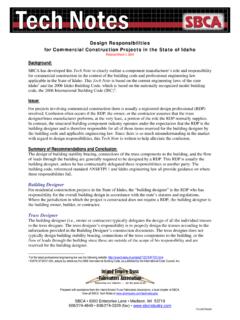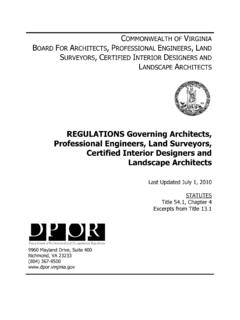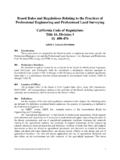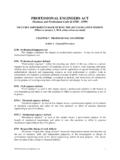Transcription of 2012 Code - Final - AIA NOVA
1 F R O M T H E O F F I CE O F G E N E R A L C O U N S EL 2018 Code of Ethics and professional Conduct Preamble Members of The American Institute of Architects are dedicated to the highest standards of professionalism, integrity, and competence. This Code of Ethics and professional Conduct states guidelines for the conduct of Members in fulfilling those obligations. The Code is arranged in three tiers of statements: Canons, Ethical Standards, and Rules of Conduct: Canons are broad principles of conduct. Ethical Standards ( ) are more specific goals toward which Members should aspire in professional performance and behavior.
2 Rules of Conduct (Rule) are mandatory; violation of a Rule is grounds for disciplinary action by the Institute. Rules of Conduct, in some instances, implement more than one Canon or Ethical Standard. The Code applies to the professional activities of all classes of Members, wherever they occur. It addresses responsibilities to the public, which the profession serves and enriches; to the clients and users of architecture and in the building industries, who help to shape the built environment; and to the art and science of architecture, that continuum of knowledge and creation which is the heritage and legacy of the profession.
3 Commentary is provided for some of the Rules of Conduct. That commentary is meant to clarify or elaborate the intent of the rule. The commentary is not part of the Code. Enforcement will be determined by application of the Rules of Conduct alone; the commentary will assist those seeking to conform their conduct to the Code and those charged with its enforcement. Statement in Compliance With Antitrust Law The following practices are not, in themselves, unethical, unprofessional, or contrary to any policy of The American Institute of Architects or any of its components: (1) submitting, at any time, competitive bids or price quotations, including in circumstances where price is the sole or principal consideration in the selection of an architect ; (2) providing discounts; or (3) providing free services.
4 Individual architects or architecture firms, acting alone and not on behalf of the Institute or any of its components, are free to decide for themselves whether or not to engage in any of these practices. Antitrust law permits the Institute, its components, or Members to advocate legislative or other government policies or actions relating to these practices. Finally, architects should continue to consult with state laws or regulations governing the practice of architecture. CANON I General Obligations Members should maintain and advance their knowledge of the art and science of architecture, respect the body of architectural accomplishment, contribute to its growth, thoughtfully consider the social and environmental impact of their professional activities, and exercise learned and uncompromised professional judgment.
5 Knowledge and Skill: Members should strive to improve their professional knowledge and skill. Rule In practicing architecture, Members shall demonstrate a consistent pattern of reasonable care and competence, and shall apply the technical knowledge and skill which is ordinarily applied by architects of good standing practicing in the same locality. Commentary: By requiring a consistent pattern of adherence to the common law standard of competence, this rule allows for discipline of a Member who more than infrequently does not achieve that standard. Isolated instances of minor lapses would not provide the basis for discipline.
6 Standards of Excellence: Members should continually seek to raise the standards of aesthetic excellence, architectural education, research, training, and practice. Natural and Cultural Heritage: Members should respect and help conserve their natural and cultural heritage while striving to improve the environment and the quality of life within it. Human Rights: Members should uphold human rights in all their professional endeavors. Rule Members shall not engage in harassment or discrimination in their professional activities on the basis of race, religion, national origin, age, disability, caregiver status, gender, gender identity, or sexual orientation.
7 Commentary: Harassment may include, but is not limited to, offensive jokes, slurs, epithets or name calling, unwelcome physical contact, or threats, intimidation, ridicule or mockery, insults or put-downs, offensive objects or pictures, and interference with work performance. Petty 2 0 18 C O D E O F E T H I C S A N D P R O F E S S I O N A L C O N D U C T 2 slights, annoyances, and isolated incidents (unless extremely serious) will not rise to the level of violation of this Rule. Rule Members shall not engage in conduct involving wanton disregard of the rights of others. Commentary: Wanton disregard under this rule includes conduct taken in disregard of (1) a high degree of risk that the Complainant would be adversely affected, and (2) that risk would be apparent to a reasonable person.
8 Reasonable person is an objective standard and considers someone who uses such qualities as attention, knowledge, intelligence, and judgement which a society requires of its members to protect their own interests and the interests of others. Wanton disregard under this rule also includes engaging in conduct that is severe or pervasive enough that a reasonable person would consider it harassing, hostile, or abusive. This includes, but is not limited to, sexual misconduct, bullying, intimidation, or retaliation. Design for Human Dignity and the Health, Safety, and Welfare of the Public: Members should employ their professional knowledge and skill to design buildings and spaces that will enhance and facilitate human dignity and the health, safety, and welfare of the individual and the public.
9 Allied Arts and Industries: Members should promote allied arts and contribute to the knowledge and capability of the building industries as a whole. CANON II Obligations to the Public Members should embrace the spirit and letter of the law governing their professional affairs and should promote and serve the public interest in their personal and professional activities. Conduct: Members should uphold the law in the conduct of their professional activities. Rule Members shall not, in the conduct of their professional practice, knowingly violate the law. Commentary: The violation of any law, local, state or federal, occurring in the conduct of a Member s professional practice, is made the basis for discipline by this rule.
10 This includes the federal Copyright Act, which prohibits copying architectural works without the permission of the copyright owner. Allegations of violations of this rule must be based on an independent finding of a violation of the law by a court of competent jurisdiction or an administrative or regulatory body. Rule Members shall neither offer nor make any payment or gift to a public official with the intent of influencing the official s judgment in connection with an existing or prospective project in which the Members are interested. Commentary: This rule does not prohibit campaign contributions made in conformity with applicable campaign financing laws.










